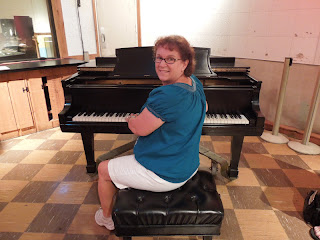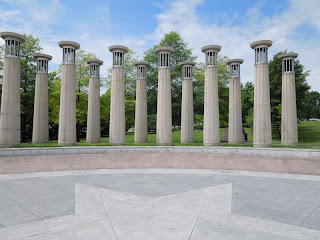We went back into Nashville to take the Studio B tour and spend a little more time in Bicentennial Park in the morning. We had a little introduction to Music Row and Studio B on our bus tour. Music Row is now lined with big multi-story buildings having to do with recording and the music industry. Reba McEntire has a beautiful building here. Mike Curb owns much of Music Roe today. One of the buildings is the Mike Curb College of Entertainment and Music Business. He bought Studio B keeping it from being torn down. In turn, he sold it to a non-profit for $1.00 with the stipulation that his college can use it as part of its course work. One of his classes is held here so students can learn how to keep the knowledge of the old recording systems alive. Studio B is a tiny building among the large buildings there today. Back in 1957 when it opened, the Quonset Hut was the only other recording studio in Nashville. Before closing its doors in 1977, 35,000 songs were recoded here with 1,000 ending up on the top ten charts. It is one of the most significant recording studios in the world. Elvis recoded 65% of his songs right here. He liked to start his recoding session at about 10:00 on Sunday nights. He would schedule his sessions to start at 6:00 but arrive late so the hourly workers would get a little extra pay. In the long list of stars recording here are some of my favorites: The Everly Brothers, Roy Orbison, Dolly Parton, Amy Grant, Willie Nelson, Wynonna, and Roger Miller. Carrie Underwood recoded her Christmas CD here recently. You can record here yourself if you want to schedule the time. Today recording is very different with so many of the stars recording in their studios right at home. As you walk through the building you see the recording systems that were used and can imagine the busy schedule they kept up. Christy sat at the very piano that Elvis used! Of course our guide was enthusiastic and had lots of stories to tell.
 |
| World Famous Studio B |
 |
| Chris is sitting at the very same piano that Elvis and countless others played. |
As part of the Bicentennial Park down from the capitol, there is a circle of bell towers that play a series of songs from its 1,000 song catalog at the top of the hour. Standing in the center you can hear your voice echo and it’s the perfect place to listen to the music. Another part of the park is the WWII Memorial and a time line done in granite with facts and quotes. Across the street is their farmers market that is open all year.
 |
| WWII Memorial The granite world revolves on water. |
 |
| Bell Towers - The place to stand is right in the middle of the circle to listen the the music at the top of the hour. |
We had a yummy lunch at Jack’s Bar-B-Q before heading to the Hermitage. We ranked it tops for ribs along with USA Today and the New York Times - yummy.
The Hermitage is the home and plantation of Andrew Jackson. We watched an excellent movie and then did the audio tour of the home and the grounds. They had just added information from his wife Rachel’s point of view. At each audio stop there was also an audio tour for kids. The whole thing was very well done. Andrew and Rachel spent their first 17 years at the Hermitage living in a two story log cabin from 1804 to 18 21. It was rustic but inside the walls were wallpapered, rugs covered the wood floors and fine furniture, china, etc. were used. It would have been considered a fine home back then on the frontier. After they moved into the mansion, they made the log home into slave quarters by taking off the second story and white washing the inside walls. It would have been inappropriate to have slaves in a two story home. The mansion was is disrepair but still salvageable when it was bought by the state of TN in the later 1800‘s. The wall paper and furnishings we see today are almost all original to the home. With stories and information about Jackson, Rachel and the slaves, we began to get a picture of life on the plantation. They never had children of their own but adopted a twin boy that was born to Rachel’s sister and they raised an Indian boy that Jackson came across after a battle in the war of 1812. The boys were raised with equal advantages. Andrew Jackson II never was able to successfully run the plantation and was pretty much a failure at everything he tried. The picture they painted of Andrew Jackson was one of a hot head but with a soft side. He seemed to be kind to his slaves as long as they cooperated. He never sold his slaves or split up families but punishment was severe if you were caught crossing him. He was known for his hot temper and it was much better is you stayed on his good side no matter what color you were. Andrew and Rachel’s enduring love story began when they started “married” life before Rachel was legally divorced. This was to haunt them all their years together. We walked the grounds listening to the audio presentation, visiting the slave quarters, outbuildings and grave site. Rachel died in 1828, as Jackson was about to begin his first term as President. He returned to the hermitage after his presidency and died here in 1845. They are buried in the beautiful garden that Rachel loved. Between the film, the audio tour and the museum, our knowledge of Jackson’s military and political career was revived. He blazed new trails and opened new possibilities on the frontier. “He was loved and loathed, revered and reviled.” He was hot headed, unconventional and his controversial side outraged the elite establishment in Washington. His enduring devotion to Rachel and his family showed another side to him.
 |
| Hermitage - Andrew Jackson's Home |
 |
| Two families lived in this slave cabin. Orinally it was a two story home for Rachel and Andrew Jackson. They lived here for 17 years before the mansion was built. |
 |
| Grave Sites of Rachel and Andrew Jackson |


No comments:
Post a Comment